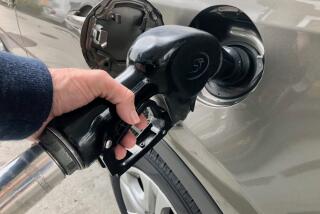Gas Going Up, but Not Enough to Alter Habits
- Share via
As you drive by gas stations today, you can’t help but notice the price of gasoline. Among all the items offered for sale in our economy, nothing generally commands a bigger sign for advertising its price than gas. Not the price of a house. Not the price of toothpaste. Not even the price of a car.
You can spot the price of a gallon of gas from 50 yards.
It’s hard to get away from it. Gas prices are supposed to be important, determining how much of our disposable income we dole out for transportation and how much economic power foreign suppliers hold over the United States. It’s a politically charged statistic, connected by history to the monopolistic corruption imposed on Americans more than a century ago by the Standard Oil trust.
All these factors explain a lot about why the price of gasoline seems to be on the minds of so many motorists, not to mention the news media, government regulators and economists. And, once again, the price of gasoline is going up.
A few weeks ago you could find gasoline for less than $1 a gallon, but now prices have popped back over the key psychological level of $1.
“We expect it to rise between now and spring,” said David Costello, an Energy Department economist. “There is lots of room for the price of gasoline to go up, if you think 20 cents a gallon is a lot.”
To some, it is.
“If I bought a sport-utility vehicle when gas was $1 per gallon and now it goes to $1.50 per gallon, I worry,” said Michael Flynn, director of the University of Michigan’s Office for the Study of Automotive Transportation. “It bothers me. Toothpaste, you don’t buy as often, and the price fluctuations you don’t notice as much.”
Because of its recent no-interest financing promotions, a lot of people bought General Motors sport-utility vehicles and trucks, Flynn said. “Those people are going to be very upset when gasoline gets back to the levels of last summer, when gas was $1.70 per gallon.”
But the price of gasoline is so cheap by any historical standard that consumers should dismiss a 20-cent-a-gallon increase. Indeed, they should easily absorb a $2 or $3 or $4 price rise.
It would take $5-a-gallon gas to radically change consumer behavior, given the historical relationships price of gasoline, average household income and the fuel efficiency of the vehicles we drive, experts say.
Gasoline prices, adjusted for inflation, peaked in 1981 and generally have been going down ever since. And most people are better able to afford gasoline than ever before. Average family income has been growing, so people have more income to spend on gasoline.
In 1981, gasoline sold for $1.38 a gallon and per-capita personal income was $11,280, according to data from the Bureau of Economic Analysis and the Energy Information Administration.
Now, gasoline sells, on average, for $1.11 a gallon nationally and per-capita income is $28,546. The drop in the ratio of gasoline price to family income means that a gallon of gas imposes less than a third of the burden on our income today than it did in 1981.
Offsetting that is the growth in vehicle usage. People drive more every year, by a margin of about 2% to 3% annually, according to Costello.
And consumers have shifted their buying to heavier, less fuel-efficient trucks and sport-utility vehicles. Between 1987 and 2001, average vehicle fuel economy declined nearly 8% to 20.4 miles per gallon, according to the Environmental Protection Agency.
Nonetheless, most experts agree that American households are spending a smaller percentage of their income on gasoline than at any time since the 1980s. And it would take a substantial jump in gasoline costs--perhaps to between $3 and $6 a gallon--to get back to where we were then.
Flynn said he would concur with such an assessment.
So, it is not surprising that although consumers grumble about relatively small increases in the cost of gasoline, they continue to disregard the cost when investing in new vehicles.
“There is no real incentive for people to buy fuel economy,” said David Cole, president of the auto research center at Altarum Corp., a nonprofit organization in Michigan. “If you go from 30 mpg to 40 mpg in a vehicle, it saves just 30 cents per day, based on 12,000 miles of driving per year.”
Even after last year’s electricity crisis in California, consumers are quickly resuming their normal outlook on energy, Cole said. Concerns about scarcity have faded. And save for environmentalists, there are few political or economic forces that advocate for energy efficiency, Cole noted.
Rather than the cost of gasoline, the availability of gasoline seems to be the most important consideration for consumers, a condition that has been reinforced steadily over the last 20 years as the real price of gasoline has dropped.
*
Ralph Vartabedian cannot answer mail personally but responds in this column to automotive questions of general interest. Please do not telephone. Write to Your Wheels, Business Section, Los Angeles Times, 202 W. 1st St., Los Angeles, CA 90012. E-mail: ralph .vartabedian@latimes.com.







